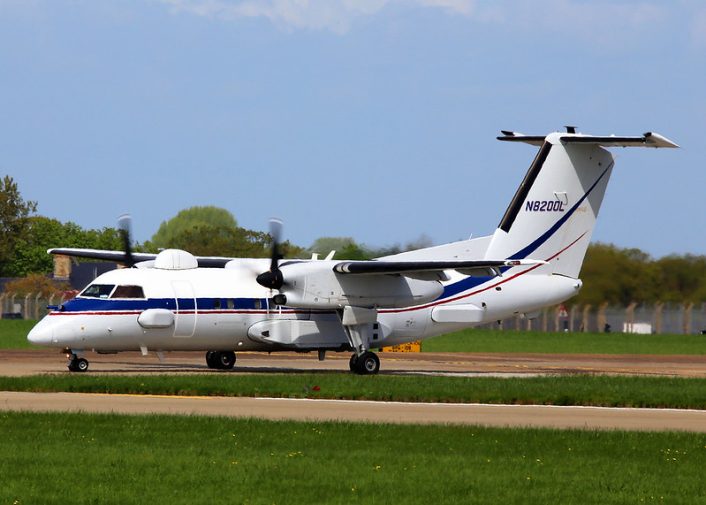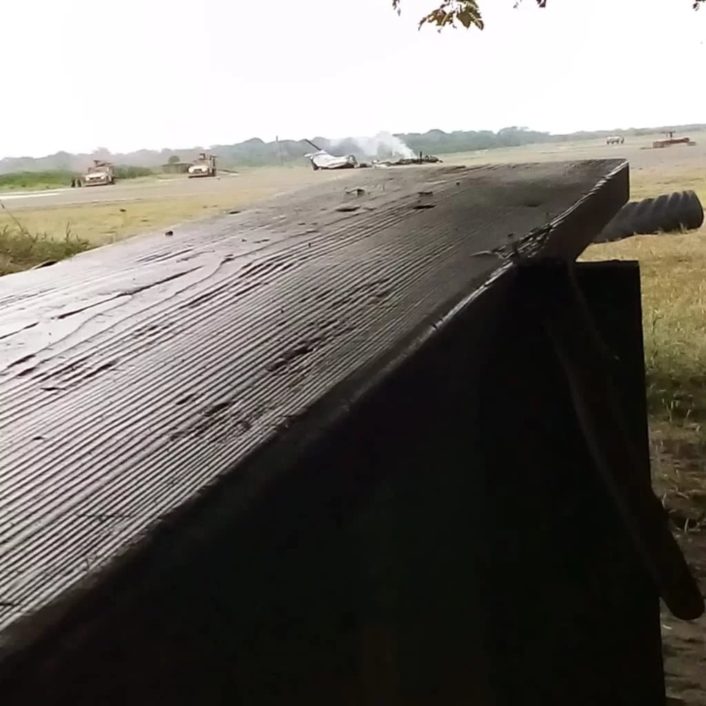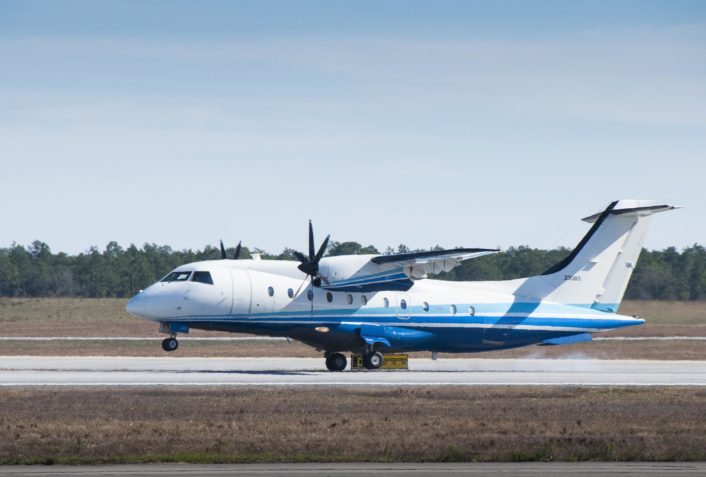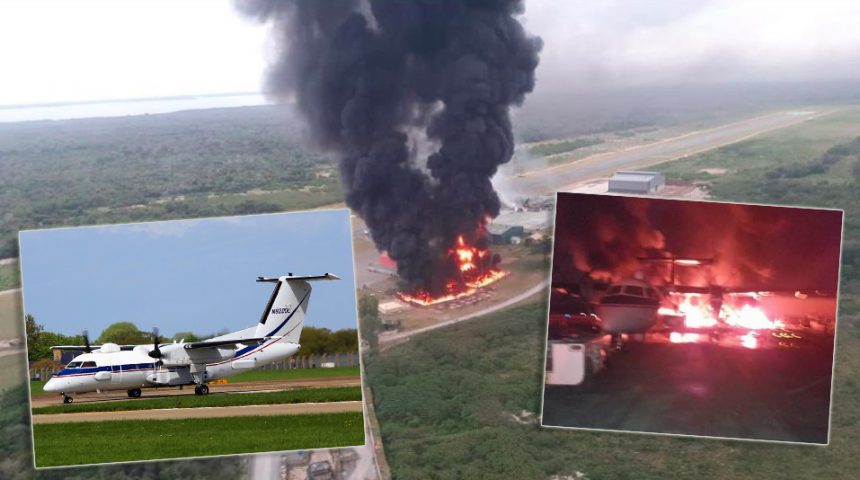Everything we know about the terrorist attack on “Camp Simba”, Kenya, and the U.S. Special Operations Command aircraft destroyed there.
On Sunday Jan. 5, 2020, at around 05:30AM LT, the Somail terrorist organization al-Shabaab attacked Manda Bay Airfield, Kenya, also known as “Camp Simba”, a base used by both U.S. and Kenyan forces.
The group posted 17 photographs showing their militants allegedly burning aircraft inside the base (one shows a fighter shooting a selfie next to a Dash 8 aircraft – more about this below), claiming 7 aircraft and 3 army vehicles were destroyed in the attack
BREAKING: #AlShabaab publishes 17 images of their fighters allegedly burning aircraft inside #US naval base in #Lamu County, #Kenya. The group says it destroyed 7 aircraft & 3 army vehicles. #KDF spox says the attack was “repulsed”. #AFRICOM say it’s monitoring the situation. pic.twitter.com/bZxJEG8ZHt
— Morad News (@MoradNews) January 5, 2020
Both AFRICOM (U.S. Africa Command) and the Kenya Defense Forces acknowledged there was an attack on the base. Initially, the KDF just said that the attack was repelled:
This morning at around 5:30 am an attempt was made to breach security at Manda Air Strip. The attempted breach was successfully repulsed. Four terrorists bodies have so far been found. The airstrip is safe.https://t.co/CXoAWBgXC4
— Kenya Defence Forces (@kdfinfo) January 5, 2020
A later AFRICOM press release provided more details and while highlighting that Al-Shabaab “exaggerated the security situation on the ground” acknowledged “damage to infrastructure and equipment”. Here’s an exerpt of the press release:
U.S. Africa Command acknowledges there was an attack by the terrorist organization al-Shabaab at Manda Bay Airfield, Kenya, today. U.S Africa Command and Kenya Defense Forces repelled the al-Shabaab attack.
Working alongside our Kenyan partners, the airfield is cleared and still in the process of being fully secured.
Al-Shabaab has put out multiple press releases exaggerating the security situation on the ground. This practice has proven common place for this terror organization.
[…]
The security situation at Manda Bay is fluid. Al-Shabaab is a terrorist group that has repeatedly communicated an intent to attack U.S. interests.
[…]
Initial reports reflect damage to infrastructure and equipment. An accountability of personnel assessment is underway. As additional facts and details emerge, we will provide an update.
According to the Associated Press, an internal Kenyan police report “said two fixed-wing aircraft, a U.S. Cessna and a Kenyan one, were destroyed along with two U.S. helicopters and multiple U.S. vehicles”. While no additional detail about the aircraft destroyed or damaged on the ground at Camp Simba has been released, several U.S. Special Operations Command (USSOCOM) aircraft regularly operate from the strip. Among them, Cessna 208, U-28 (PC-12), C-146s (Dornier 328), Dash 8s, CN235s, as well as UH-60 and MH-6 helicopters along with MQ-9 Reaper RPV (Remotely Piloted Vehicles) according to Scramble Magazine. Unconfirmed reports circulating on social media say that at least two U.S. aircraft were destroyed: a C-146A Wolfhound (US military designation of the Do-328) and a civil-registered DHC-8-Q202 operated by SOCOM.
Al Shabab has destroyed two planes this morning in the attack at Manda Bay Airfield, #Kenya. SOCOM C146A Wolfhound and AFSOC civil reg Dynamic Avlease DHC-8-202 N8200L pic.twitter.com/7beAZqi9ms
— Manu Gómez (@GDarkconrad) January 5, 2020
Indeed, the photographs posted by Al-Shabaab during the attack clearly show a heavily modified DHC-8 in flames. Based on the livery, the aircraft can be N8200L, one of the two heavily modified twin engine Dash-8s that fly as part of a fleet of aircraft known as SOCOM Tactical Airborne Multi-Sensor Platforms, or STAMP. The aircraft has been spotted operating in the Libyan theatre last April.
#US Special Operations Command Dash 8 Q200 (N8200L) back to Souda Bay AB after an ISR (Intelligence, Surveillance and Reconnaissance) mission over Tripoli, #Libya pic.twitter.com/7ffun4uhK7
— ItaMilRadar (@ItaMilRadar) April 12, 2019
According to Joseph Trevithick at The War Zone the SOCOM’s Dash-8s are believed to be equipped with wide-area sensors to carry out suveillance misssions in support of special forces “tracking small groups of terrorists across vast areas where the enemy might be able to use the terrain or local populations to otherwise hide their movements. The aircraft may also have additional signals intelligence equipment to detect and monitor enemy communications, especially cell phone signals, in order to help refine their search areas.”
With that in mind, the terrorists may have destroyed one of the shadowy assets used by the U.S. to hunt them in that theatre!

Dealing with the other aircraft reportedly destroyed at Camp Simba, another photo, allegedly taken by KDF in the aftermath of the attack, seems to confirm it was a C-146A.

According to SOCOM, “the C-146A Wolfhound’s primary mission is to provide U.S. Special Operations Command flexible, responsive and operational movement of small teams needed in support of Theater Special Operations Commands. Airlift missions are conducted by Air Force Special Operations Command aircrews to prepared and semi-prepared airfields around the world.”

Therefore, it looks like at least two SOCOM aircraft were destroyed at Camp Simba and we will update this post as new details emerge.
Update Jan. 5, 21.00 GMT:
AFRICOM has released a new statement according to which “six contractor-operated civilian aircraft” were damaged. Considered the C-146s are operated by the U.S. Air Force, it means the second aircraft (the one photographed in the aftermath of the attack) can’t be a Wolfhound.
UPDATE: U.S. Statement on Manda Bay Terrorist Attack – https://t.co/iO01z8Zpg4 pic.twitter.com/Rpx1xwFkZ1
— US AFRICOM (@USAfricaCommand) January 5, 2020
Update Jan. 6, 09.00 GMT:
As already explained, the second aircraft should not be a C-146A. Some sources suggested it might be a Super King Air variant.
🇺🇸💥🇰🇪
Beechcraft Super King Air variant destroyed at Camp Simba #Lamu #Kenya this morning? https://t.co/6cNEs7wyyU pic.twitter.com/2EWjIc8Kqv
— Ian Cox (@IanECox) January 5, 2020
Indeed, several civil-registered King Airs (which appear similar to general aviation aircraft during their covert missions), are actually heavily modified to operate as spyplanes in support of the U.S. Department of Defense and Special Operations across the globe. We have often reported about the “civilian versions” of the MC-12W, an ISR (Intelligence Surveillance Reconnaissance) platform operated by the U.S. Air Force and equipped with a full array of sensors, a ground exploitation cell, line-of-sight and satellite communications datalinks, a robust voice communications suite as well as an electro-optical infrared sensor with a laser illuminator and designator, and particularly capable to “find, fix, and finish” bad guys. Some “famous” examples are the N351DY that has often operated in North Africa, or the N6351V, that made an emergency landing in Iraq, where many suck King Airs can be regularly tracked online by means of ADS-B. While not all aircraft carry the same sensor suite, many King Airs with liveries that disguise their clandestine missions are known to support US SOCOM.
A satellite image of Manda Bay airfield dated Nov. 27, 2019, shows what seem to be a King Air on the tarmac.
Manda Bay airfield in Kenya on 27 Nov 2019 https://t.co/FCZYFfm6w0 pic.twitter.com/mflnwuefSD
— Samir (@obretix) January 5, 2020
Among the modified Beech King Air 350s that have been spotted flying over Iraq or Libya recently (Somalia and Kenya are not properly covered by ground ADS-B receivers so we can’t get a good “picture” of that area), one that *based on the low rez shot from distance of the wreckage* seem to have something in common with aircraft destroyed in the Camp Simba attack is the N60125.

H/T to @guidoolimpio and @IanECox for the heads-up.









